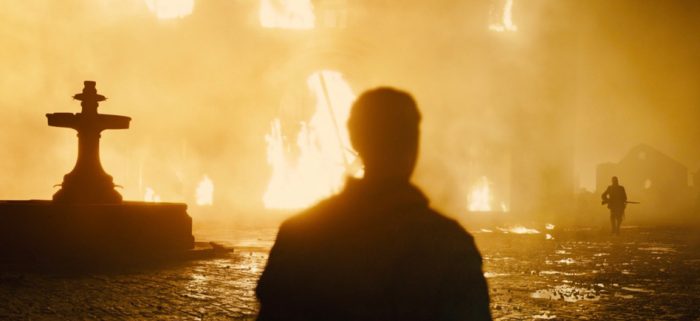Not since Mad Max: Fury Road has a film so fully embraced the “motion” part of motion pictures. Sam Mendes‘ jaw-dropping, nerve-jangling World War I epic 1917 is designed to look like one extremely long take from start to finish, resulting in a film that almost never sits still. The clock is ticking, and the narrative thrusts the characters forward as if a strong wind is at their backs.
One-take movies are nothing new, and 1917 ran a serious risk of being gimmicky. But Mendes, working with master cinematographer Roger Deakins, uses the single-take concept to fully enhance the narrative. Best of all, the film underscores its technical prowess with a raw, emotional story that finds beauty struggling to push through all the muck and mire. In 1917, war is hell, but it’s a hell you can find your way back from as long as you remember your humanity.
Before all the bombing, and bloodshed, and anxiety-inducing horror of 1917 starts, and before the camera starts moving, and moving, and moving, Mendes opens his film on a simple, peaceful moment: two British soldiers lounging about in a field. They are the almost painfully innocent Blake (Dean-Charles Chapman) and his rough, gruff pal Schofield (George MacKay). It’s an altogether jarring way to open a war movie – with such quiet tranquility. And it doesn’t last. Soon, Blake and Schofield are tasked with a suicide mission: they have to go behind enemy lines to stop an impending attack and prevent an ambush by the Germans. The clock is ticking, and if Blake and Schofield don’t get to where they need to be in time, thousands of their fellow soldiers will be slaughtered. To make the mission extra stressful, one of the soldiers in danger is Blake’s older brother.
And with that, 1917 is off like a flash. Mendes and Deakins stay with the men every step of their journey, which means no cutting. It also means the camera is limited in where it can go. As a result, 1917 is made up of traveling shots, many of which involve the camera slowly (or in some cases, swiftly) backing away from Blake and Schofield as they hurry to catch up with it. The steady movement of the camera is never distracting, although there are one or two moments – one of which involves a zoom-in on a pile of rocks that looks distractingly digital – that seem a tad gimmicky.
But not gimmicky enough to sink the endeavor. From a purely technical standpoint, 1917 is a marvel. Roger Deakins is already held in high regard as one of the best cinematographers in the biz, but here, he even outdoes himself. Aside from the consistently traveling camera, Deakins also gets to stage awe-inspiring sequences that burn themselves into your brain, such as a moment where Schofield runs through a bombed-out village at night while the sky explodes from whizzing signal flares. The shadows bend and twist themselves, turning the ruins into an almost alien landscape. I don’t think I’ve ever seen anything like it.
Much is going to be made about the technical elements of 1917, but it’s important to acknowledge that the film is more than a series of impressive camera angles. The script, by Mendes and Krysty Wilson-Cairns, is often disarmingly powerful in the way it presents both the horrors of war and the glimpses of beauty lurking beneath. 1917 is a consistently frightening film, full of landscapes littered with corpses wrapped in barbed-wire, dotted with burning houses, and brimming with rats feeding on the dead. It’s like a long one-take journey through the bowels of hell. We feel the weight of all that nightmarish imagery, and we also feel the weight of it on our characters. As Schofield, MacKay, giving a quiet, devastating performance, fully embodies weariness – we feel the emotional, mental, and physical exhaustion placed on him the further he goes.
All of that horror could sap a person’s soul and reduce them to a hollow husk. But as terrifying as 1917 can be (and trust me, it gets plenty terrifying – several scenes seem tailor-made to induce anxiety attacks), it’s also an achingly pure, and even tender saga. After clawing their way through No Man’s Land, Blake and Schofield come upon a series of recently chopped-down cherry trees, their blossoms bright as fresh snow. Schofield wonders if chopping them down has killed them for good, but Blake assures him they’ll sprout and bloom again. Life will rise up from death.
There are moments like this peppered all through 1917. Moments where the film briefly pauses and takes it all in, like when Schofield ends up on a truck with other soldiers and listens to them bullshitting each other. Or like when Schofield ends up in the basement of a bombed-out home where he discovers a young French woman (Claire Duburcq) caring for an orphaned baby. While tending to a wound on Schofield’s head, she tenderly touches the side of his face. It’s not meant to be a romantic gesture, it’s simply a human one. A reminder that there’s still some semblance of compassion lurking beneath all this killing. These tender, human, humane moments are what truly make 1917 one of the year’s best films.
/Film Rating: 9 out of 10
The post ‘1917’ Review: Sam Mendes’ One-Take War Pic is a Technical Marvel Loaded With Emotional Resonance appeared first on /Film.
from /Film https://ift.tt/2QTodtO
via IFTTT

Comments
Post a Comment